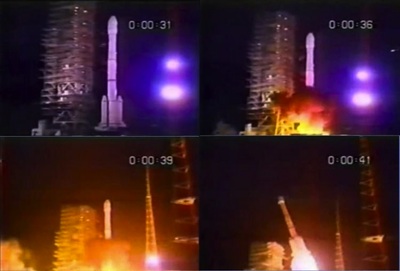Mist around the CZ-3B disaster (part 2)by Chen Lan
|
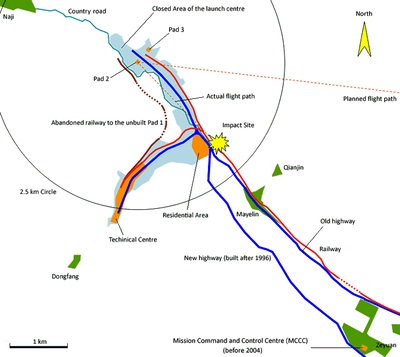 Map of the residential area of the launch center [larger version] (credit: Go Taikonauts!) |
The residential area is just inside the main gate of the launch center. Two roads, an old one and a new highway branch from the expressway to the east (built after 1996), join before the main gate and pass it from southeast to northwest. A railway, in parallel with the old road, is at its northeast side. After the gate, both the highway and the railway have a branch to the technical center. Inside the gate, at southwest side of the main road, there is a small park, the hotel, and the Coordination Building where Chinese launch crews usually live and work. There is also a hospital and other logistics facilities in the residential area. To the northeast side of the road are just mountains.
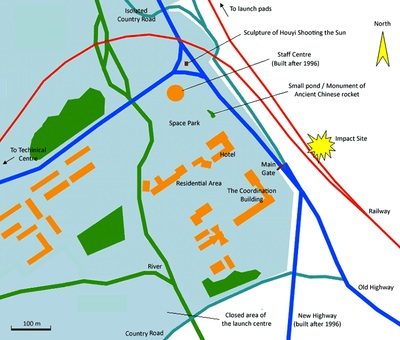 Map of the launch center and nearby villages. [larger version] (credit: Go Taikonauts!) |
According to official news and various witness reports, the rocket crashed “1,850 m away from the launch pad”, “a hillside to the right of the gate”, or “on the side of the Coordination Building.” It can almost be sure that the crash site is at a hillside northeast of the road, just opposite the two buildings across the main road. Zak’s article also concluded that the rocket crashed just across the road from the hotel for the foreigners. All this evidence is very consistent. The only conflicting testimony is what the American safety engineer Campbell recalled, that his hotel is 200 feet (60 meters) to the east of the epicentre. From the map and the nearby terrain, it seems unlikely. At 200 feet west of the hotel, there is only a small park. However, Campbell’s other claim, that the railway below the hill was buried by rocks and dirt after the explosion, confirmed that the impact site was northeast of the road where there is mountainous terrain. It is at least 200 metres from the hotel and the Coordination Building. Finally, the Chinamil story about the guard indicated that the impact site was only about 30 meters from the guard post at the gate. From the map, the nearest hillside can be found about 100 meters away from the gate. The distance is obviously overstated, but it shows how close the impact site is to the gate. It is actually the most reliable evidence for the impact site. The crash site is about 900 to 1,000 meters south from the normal path.
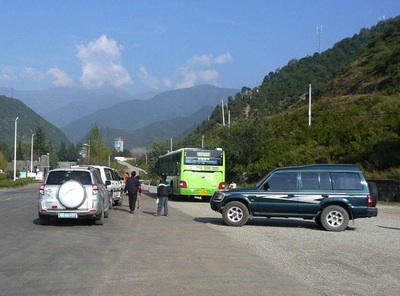 A car-park about one hundred meters away from the main gate. At the right, there is a hillside where the suspected impact site of the crashed CZ-3B in 1996 is located. Please note that the railway is not visible in this photo, but the slope between the railway and highway can be seen. This photo was taken by a tourist in recent years. (credit: Chinese internet) |
Since the anomaly appeared almost at the beginning, why didn’t the Chinese destroy the rocket by radio, or why wasn’t the rocket’s self-destruct system activated? In fact, Chinese rockets have both ground-controlled and on-board automatic destructive systems since the earliest CZ-2. However, is also a special procedure during the first 15 seconds for those vehicles launched from Xichang. For those launches, the destructive system will not work so as to protect the launch site, even if the rocket malfunctions. Also, if the on-board system detects an anomaly, it will delay 15 seconds before exploding the rocket, which allows the ground control to select a relatively safer impact zone by sending a manual destruct command. It is still unclear why the destruct command was not executed between the 15th second and the 22nd second, when it crashed. Perhaps the automated system had already issued the destruct command, but the rocket crashed before the 15-second delay was reached. It may also be too short a period for the ground control crew to respond within the seven seconds available to manually destroy the launcher.
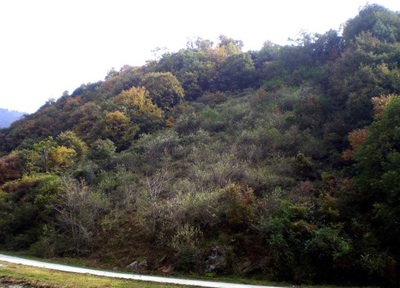 The alleged impact site. It looks like the slope between the railway and highway. (credit: Chinese internet) |
Casualties
The biggest question is about the number of casualties. Confirmed information indicated that two engineers from CALT, Qian Zhiying and Yang Linzhen, perished. At least one of them was among the four who were still in the Coordination Building at the moment the rocket crashed. The rest of the four survived in a building only about 200 meters from the epicentre, though they were severely injured and nearly died. Liang Dongyuan’s article in National Geographic and many other reports all mentioned that they violated the order for evacuation. The Beijing Youth Daily journalist and official accounts showed that evacuation was planned and performed. Unfortunately, the CALT casualties and injured and the guard story show that the execution was not very strict.
Witnesses at the launch pad (the Beijing Youth journalist) and technical center (American engineers), as well as those at the MCCC (the CCTV journalist) all reported a strong shock wave that smashed glass into fragments, but no one saw any fatalities or severely injured.
| Since the anomaly appeared almost at the beginning, why didn’t the Chinese destroy the rocket by radio, or why wasn’t the rocket’s self-destruct system activated? |
Two dead from the launch crew from outside of XSLC could be believed a credible number. There were comments in Internet forums that no persons from the launch center (a military unit) died in this accident. It could not be seen as reliable but we have some clues from official sources. The Chinamil web site recently published a report mentioning that 30 launch site staff have died on duty through 2010. We have identified nearly 10 from various reports on Chinese media who did not perish in the 1996 accident. In other words, even if there were casualties in launch site staff, there were definitely not many. It, in turn, suggests that evacuation was indeed done in a certain way. Otherwise, many more launch staff (inside and outside XSLC) would have been killed.
But how about nearby villagers? Videos have shown large-scale damage along the road to the center. Many sources, including numerous official news and photos during the last two decades, as well as Zak’s article, have confirmed that farmers stay and work very close to the launch center. Though there was no trace of burning, it is true that the powerful shock wave must have pushed down countless houses. It is reasonable to speculate that a catastrophe like this would kill many people.
It will be helpful to take a look at the distribution of local houses and population near the launch centre. In fact, Xichang Satellite Launch Center (XSLC) is not located in Xichang City. Instead, it is located within the Zeyuan Township, Mianning County, Sichuan Province, about 60 kilometers from Xichang City. It has to be noted that China’s rural administrative hierarchy has four levels: province, county, township, and town/village. Within the jurisdiction of the Zeyuan Township, there are 10 villages. Within four kilometers of the launch pad, there is Bayi Village to the northwest and Naji Village to the west, Dongfang Village to the south of the technical center, Mayelin Village just outside the main gate, and Qianjin Village to the east of Mayelin. The latter two villages are downrange of the launch center. Four of these villages—Bayi, Dongfang, Mayelin, and Qianji—were previously within the launch center, but were relocated to current locations in the early 1980s before the center began operations. Bayi was further relocated to a site eight kilometers from the launch pad after the 1996 disaster. However, their farmland is still around the center. Farmers often come back and work there. The centre (except for the MCCC) is a closed area which blocks the two northwest villages (Bayi and Naji). As a result, an isolated country road from the main gate to west of the launch area was built to allow villagers to traverse the launch center without entering it.
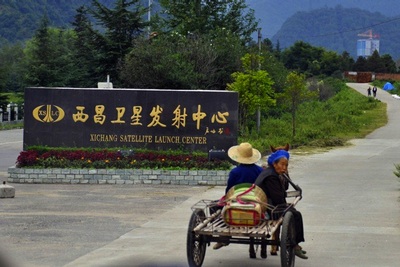 The villagers and the main gate. Villagers can go to Naji and Bayi Villages through a country road (at the right on the photo) crossing the launch center. (credit: Chinese internet) |
The fifth population census completed in November 2000 shows that the Zeyuan Township has a population of 9,861 people. In 2007, it was about 12,000. Among six nearby villages, Qianjin and Dongfang have only a few dozen residents, while all others have more than 300 people. Mayelin is the largest one, having about 1,200 registered residents in 2007. It grew rapidly to 1,600 in 2010, among which about 1,000 live there all the year and the rest are in cities as immigrant workers. Unfortunately, it is only about one kilometer from the crash site. This village extends hundreds of meters along the road. It is very consistent with the smuggled videos showing large-scale damage along the road.
The key to the casualty number is whether evacuation was done in villages, especially Mayelin, in 1996. In 2007 and 2010, China launched two lunar orbiters from Xichang. These two launches were the most significant and most open space launches in Xichang in the last decade, which attracted a lot of journalists. As a result, there are a lot of reports on the launch center and nearby villages, as well as people there. According to interviews with local farmers, evacuation in Mayelin and other villages started as early as 1984. From 1998, all villagers were asked to leave a 2.5-kilometer circle around the launch site, and all people at distances of 2.5 to 6 kilometers from the launch pad were asked to go to an empty space, such as the playground of a school. But there were always some people, mostly elderly people, who refused to leave their houses, even in recent years. In the early days, if it was a night launch, the launch center always arranged a film show at the school playgrounds with sweets given to children.
| So far, we are unable to prove whether the official casualty number is accurate or not. But we can almost certainly rule out heavy casualties. |
Let’s assume that there was no evacuation in February 1996, resulting in a great number of casualties, for instance 500, as rumored in the West. Such casualties should be mostly in Mayelin because the next nearby village, Qianjin, had only a few dozen people, and is behind a hill that would have been able to block the shock wave. A little further away is a small town and the MCCC where no large damage or casualties were reported. Also, at 3:00 am, people were very unlikely to be working in their fields. In the case of Mayelin, considering its population growth in recent years, the number of residents 17 years ago should be reasonably predicted to be between 500 and 1,000, or even less. If 500 died there, Mayelin would have become a dead village for many years, or even never allowed to exist because of safety reasons. But it was not. It is hard to believe its population continues to grow and even doubled following the catastrophe.
Also, there were so many people who lived nearby the launch center, or who were involved in the launch and rescue operation. But there has been not a single piece of evidence on the Internet indicating heavy casualties during the last 17 years. China’s Internet has become an open space for public opinion with increasing freedom. It is difficult to cover up a disaster on such a scale, even it happened 17 years ago. Another piece of evidence supporting the smaller casualty number is what the Vice-Commander said in the MCCC a few hours after the accident. Whether the initial death number was “seven” or “several”—which are similar in Chinese pronunciation—it was obtained through a quick check. Considering the efficiency and capability of China’s centralized management system, a large error in the number is unlikely. Furthermore, just one year before (in 1995), a CZ-2E exploded during launch and its debris killed six people. It would be quite illogical to not to enforce evacuation after such a launch failure, especially for the maiden flight of a new vehicle. All of these facts tend to lead to a conclusion that evacuation was indeed performed, though not as strictly as it should have been, and most villagers had survived.
There are rumors about local dead on the Chinese Internet. One story is that the dead include a widow and her son, and a farmer just outside his door, who all refused to leave home. A police officer who was responsible for the evacuation and also had a close relationship with the widow committed suicide a few days later. However, this story is difficult to verify.
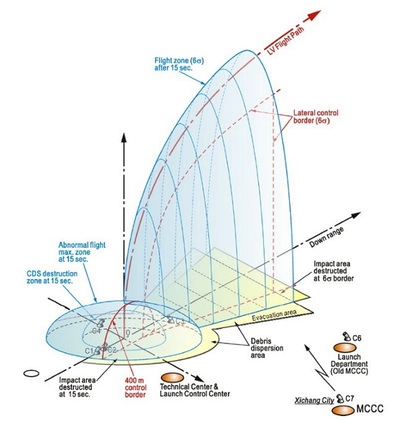 12. A picture in the User’s Manual of the Long March 3A Series Launch Vehicle showing range safety control in the XSLC. [larger version] (credit: CGWIC) |
There are still two questions that remain unanswered: the trucks and the crowd at the gate, described in Zak’s article. According to Chinese witnesses, the trucks just carried boxes packed with material rescued from the Coordination Building. In Zak’s article, it is the unnamed eyewitness who draws conclusions by guessing. Its reliability is even much lower than the Chinese testimony and it could not be considered as evidence. Then, the crowd gathered at the gate is unable to prove anything. It was many hours before the launch and they could have been easily moved out during the last minutes, if the evacuation was performed as planned.
So far, we are unable to prove whether the official casualty number is accurate or not. But we can almost certainly rule out heavy casualties. It could be six people or more than six, but very unlikely to have been hundreds. The official number is still the most worthy source to trust, unless evidence to the contrary can be provided.
The mist around the CZ-3B disaster in 1996 has been there for 17 years. With information publicized during these 17 years, from both Chinese and Western witness reports to messages revealed from official sources, we are now able to see the disaster much clearer than before. Many details have been confirmed. Heavy casualties can almost certainly be ruled out. But there are still a string of questions to be answered. How many people exactly were killed in this accident? Was there really an Israeli and why has he disappeared since then? Why didn’t the rocket self-destruct? What are the particulars of the dead villagers? Why were they in their homes and killed? All these questions are left to future historians, unless China decides to take this up on its own. In the recent past, China has seen increasing transparency and more open discussions about controversial historical events, policy, and societal developments. To fully clarify the details around the 1996 launch failure could become another milestone in the development of the modern China. Whenever China has decided to lighten up the darkness of its past it has earned increasing respect from the international community. The events during the night of the February 15, 1996, would offer another such an opportunity.
